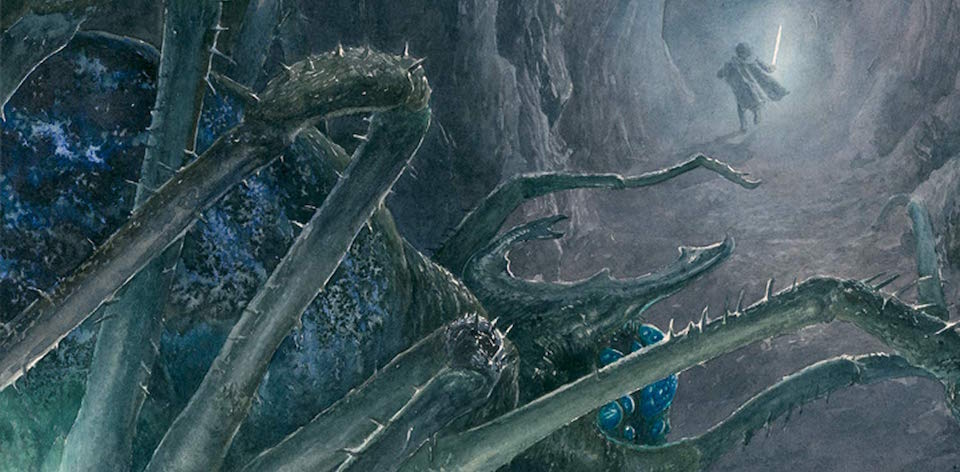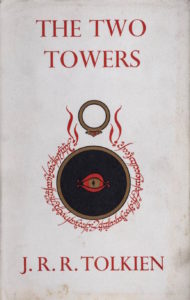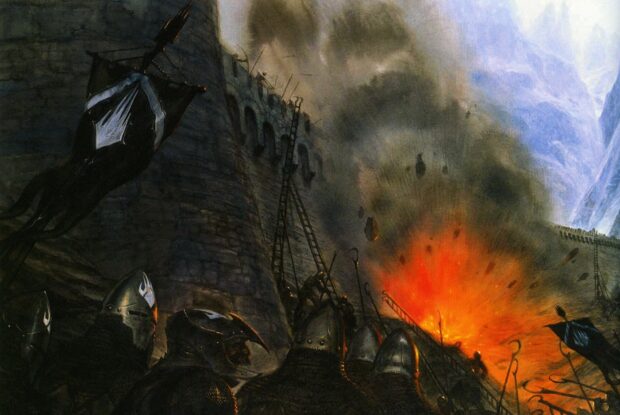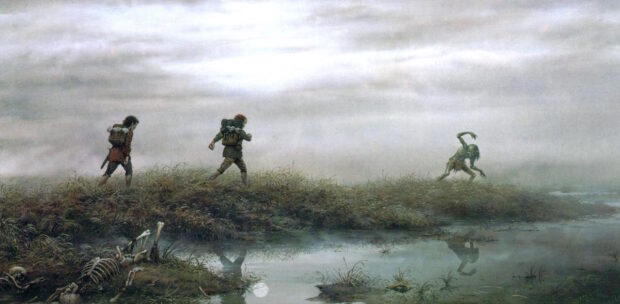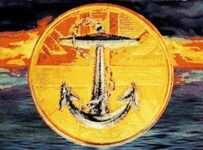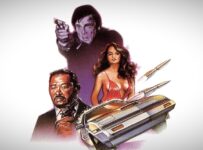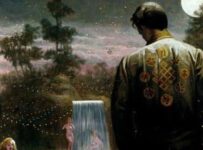Welcome back to The Read Goes Ever On: a casual and personal reading (and in some cases a very slow re-reading) of the works of J.R.R. Tolkien.

THE TWO TOWERS is a tricky subject from the outset. While it’s now well-known that The Lord of the Rings was published as three books instead of a singular due to post-WW2 publishing constraints, it’s perhaps the hardest of the three parts to talk about individually.
When the publication decision was made to divide The Lord of the Rings into three parts, Tolkien commented in a letter to Rayner Unwin (dated 17 August 1953) that “The Two Towers gets as near as possible to finding a title to cover the widely divergent Books 3 and 4; and can be left ambiguous – it might refer to Isengard and Barad-dûr, or to Minas Tirith and B; or Isengard and Cirith Ungol.”
Yet only a few months later, when delivering the “carefully corrected” copy of the first half of the second volume, Tolkien had changed his mind:
“I am not at all happy about the title ‘the Two Towers’. It must if there is any real reference in it to Vol II refer to Orthanc and the Tower of Cirith Ungol. But since there is so much made of the basic opposition of the Dark Tower and Minas Tirith, that seems very misleading. There is, of course, actually no real connecting link between Books III and IV, when cut off and presented separately as a volume.”
Which brings us to the crux of the issue when discussing this as its own piece: it’s a fragment of a whole. If The Lord of the Rings is the last movement of Tolkien’s mythopoeia, then THE TWO TOWERS is the middle two chapters of that ending. Peter Jackson encountered this dilemma when crafting the film adaptations, shuffling the death of Boromir to the end of this first film and climaxing his second with the Battle of Helm’s Deep. The second volume is a very different beast in print.
Originally published in November 1954, four months after The Fellowship of the Ring, Book Three and Book Four of the volume broadly cover the war in Rohan in the first half, and the journey of Frodo, Sam and Gollum in the second. So pervasive is Jackson’s vision that these elements were reversed in my mind, a vibe compounded by the amount of time it’s been since I last picked up these books. If anything, this mental transposition shows the enduring malleability of legendary tales while solidifying LOTR‘s status in modern mythology, just as Tolkien partly set out to do.
When the book opens, Merry and Pippin have been captured by Orcs, with Arogorn, Legolas and Gimli pursue. The trio unexpectedly encounter Gandalf, who was indeed killed in his fight with the ancient Balrog in the previous book, but has been returned to Middle-Earth for the coming fight. Together they ride to the kingdom of Rohan to convince king Théoden to aid them in the battle against darkness. Meanwhile, Merry and Pippin meet Treebeard of the ancient Ents. The plots converge as the Ents march on Isengard, effectively defeating Saruman, while Treebeard and Gandalf send aid to Helm’s Deep, helping the Rohirrim defeat the Orcs.
These sections are where all that pre-reading of The Silmarillion and its expansions starts to come in handy. Treebeard speaks of “the time of war between Sauron and the Men of the Sea” and enquires about Radagast, first mentioned in The Hobbit but barely referenced again aside from being a plot device for Saruman’s treachery. (There are essays on his fellow wizards and the Palantíri, the seeing stone the Hobbits pick up in this book, in Unfinished Tales). There’s reference to the “old alliance with Gondor,” a crucial bit of continuity between the Last Alliance of Elves and Men and the coming events of The Return of the King.
Once again, what fascinated me this time around were all those little connections I’d missed in previous reads. In describing the history of the Palantíri, Gandalf recounts a Rhyme of Lore and the “Seven stars and seven stones/And one white tree” — a direct reference to the Downfall of Númenor (recounted in The Silmarillion and Unfinished Tales of Númenor and Middle-earth, of course). When Faramir speaks of Men as a “failing people” he notes that the “Men of Númenor were settled far and wide on the shores and seaward regions of the Great Lands.” Indeed, a casual comparison between the great spider Shelob and the creature encountered by Beren and Lúthien speaks to how the Ring cycle is just a part of a longer tale. In a moment of self-awareness, Sam wonders “if we shall ever be put into songs or tales.” They just might, Sam. They just might.
What surprised me most in this re-read was how much of Helm’s Deep takes part in the first half of THE TWO TOWERS (in Book 3 effectively), returning to focus on the primary Hobbits in the second half. This section is almost ingrained into every self-respecting geek’s memory: Frodo and Sam capture Gollum, who leads them across the Dead Marshes. They are in turn captured by Faramir, brother of Boromir, and his rangers, who manages to resist the temptation of the Ring (unlike his brother). There’s a fair bit of Gollum being torn between his growing bond with Frodo and his lust for the Ring, but he ultimately betrays Sam and Frodo by leading them into the lair of Shelob in the tunnels of Cirith Ungol.
“But that’s a long tale, of course, and it goes on past the happiness and into grief and beyond it.”
So, the book we now know as THE TWO TOWERS ends on something of a down note, with Frodo barely alive after his encounter with Shelob, and Sam taking on the quest by himself. This was setting geekdom up for a series of Empire Strikes Back endings that would take place in the middle chapter of all worthy fantasy series until the end of time. Tolkien’s contemporary readers had to wait a little less than a year before the tale would be continued, while we can devour it all in one hit as the author intended.
Which brings me to some great advice: don’t do what I did and leave your re-reading for a year. I started on my great Tolkien task back in April 2019, but didn’t pick up the LOTR re-read until about a year later as lockdown was starting. It was hard to concentrate on anything last year so I let some of it go. Returning to Tolkien in 2021, having been through one of the great tales of our age, it was a breath of fresh air to a weary reader.
In the next instalment of The Read Goes Ever On, we follow the ring all the way to cracks of Mount Doom! No spoilers necessary: it’s Books V and VI of The Lord of the Rings as we witness The Return of the King.

